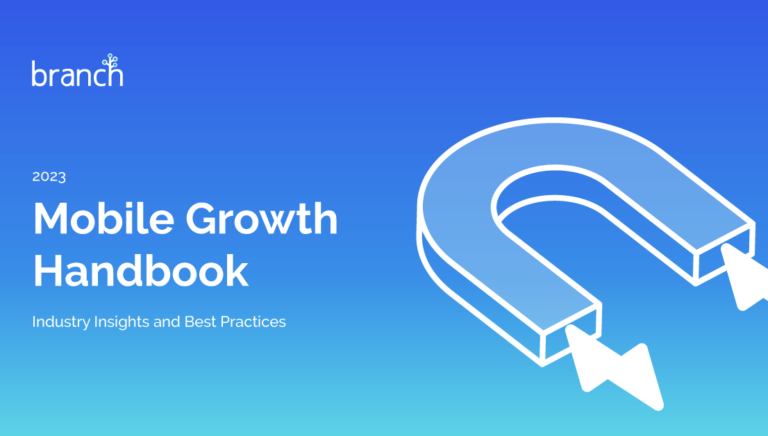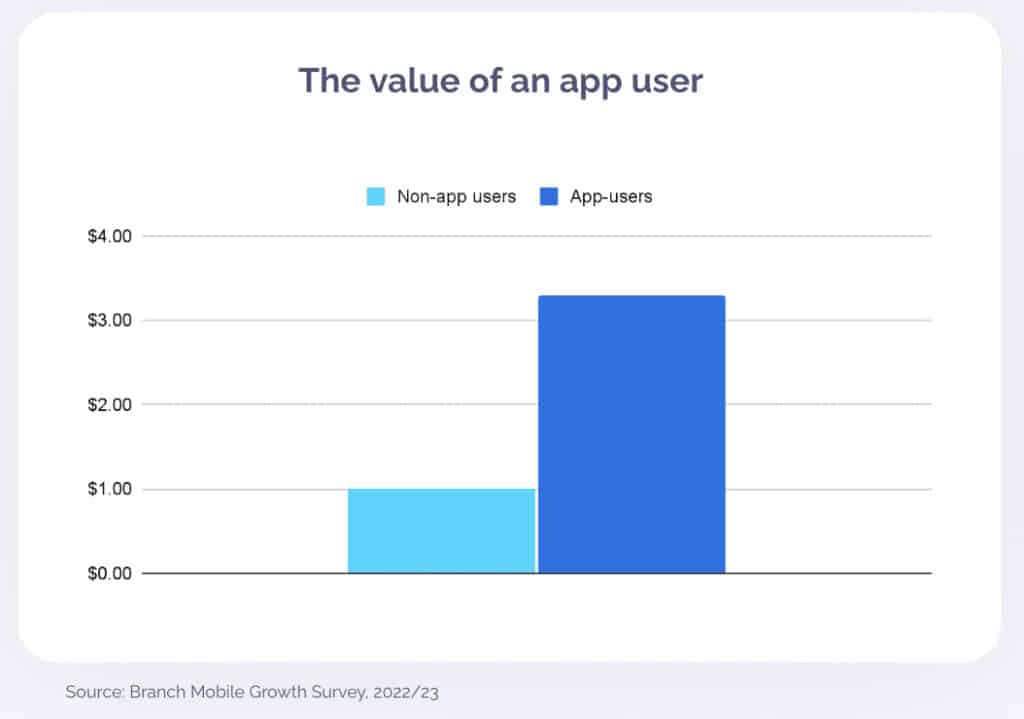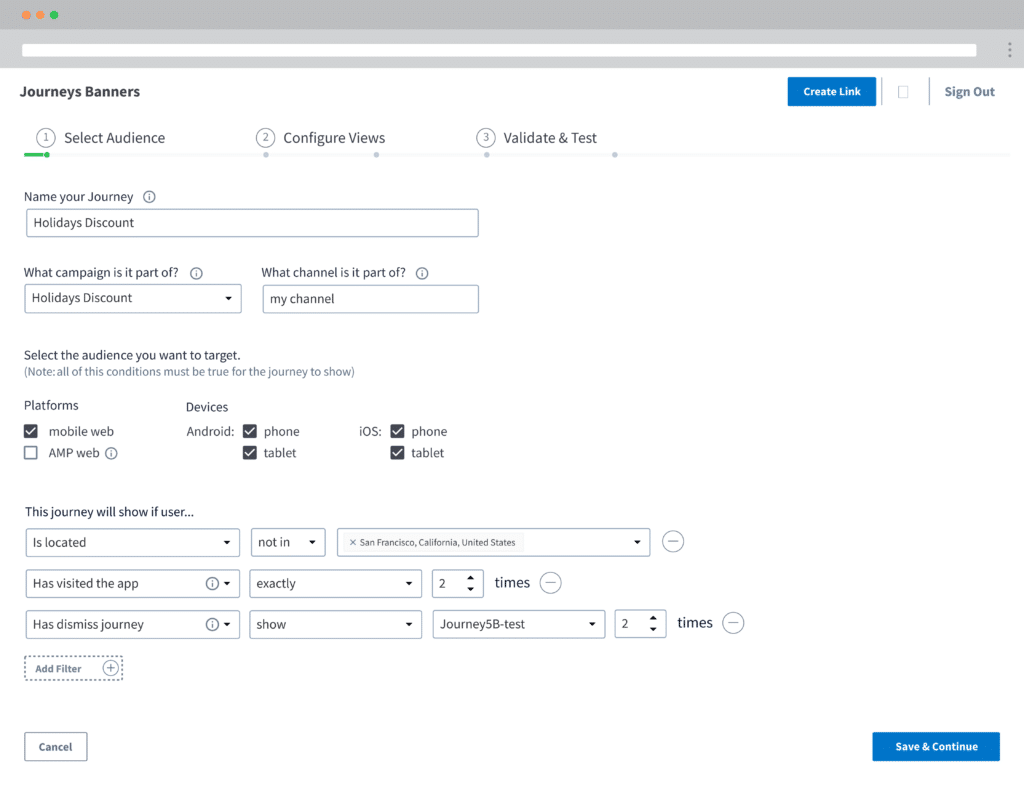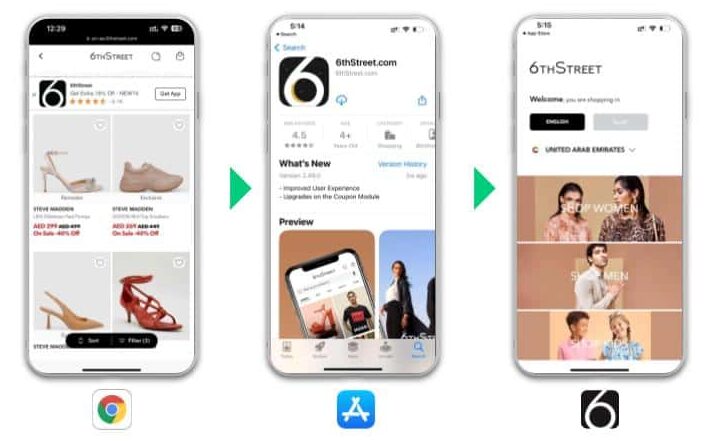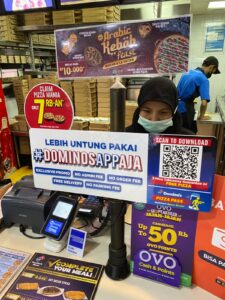MOBILE APP MARKETING
What are app marketing strategies and examples?
Help turn your “window shoppers” into mobile app users
People often browse a store’s wares through the window without any intention of actually going inside the store and making a purchase.
Similarly, some customers may look at your mobile website or visit your brick-and-mortar store without any intention of downloading your mobile app.
That’s precisely where app marketing strategy comes in.
A good app marketing strategy can help you build brand awareness and affinity toward your brand. That way, when potential customers visit your physical store or browse through online channels, they have a higher likelihood of downloading your mobile app. In addition, app marketing strategies — when done right — can help you drive significantly higher app downloads, engagement rates, and overall customer lifetime value (LTV).
In fact, our Mobile Growth survey found that for every one dollar a non-app user spends, app users spend $3.30 — more than 3x. Furthermore, 70% of time spent with digital media takes place on mobile, and of that, 92% of the time is spent in mobile apps. So it’s no surprise that brands are taking a more conscious effort to optimize their app marketing strategy to increase app downloads.
However, customers are increasingly intentional about where their time and money goes as well as being critical of the convenience of their shopping experience — both pre- and post-purchase. Making a shopping experience more convenient can come in the form of features and services like free delivery — which has the potential to be the top online purchase driver — followed by coupons and discounts, and an easy return policy.
When you integrate these offerings into your mobile app marketing strategy, you can deliver a more customer-centric experience to your buyers while driving revenue.
How to build an effective app marketing strategy
In this guide, we share how you can build an effective app marketing strategy. From tools that can supplement your marketing efforts to real-life examples of brands that are already driving success from different tactics, this guide is full of helpful strategies you can implement immediately.
What is an app marketing strategy?
Research confirms 40% of smartphone users use app stores to browse for apps. However, a larger percentage of users discover apps while binging content on social media platforms, landing on a promotional display ad, or when they visit a retail store. So it’s evident you need to cast a wider net and increase awareness of your mobile app through different channels.
Enter app marketing.
An app marketing strategy is a focused, evergreen process that uses a combination of owned, earned, and paid channels to promote a mobile app.
Benefits of app marketing
The goal of app marketing is to drive higher app downloads, re-engage existing customers, and increase revenue. Brands that implemented mobile app marketing strategies saw improved conversion rates throughout the funnel, improved advertising ROI, and increased customer LTV.
“Be patient, have a long-term perspective on organic growth, and make sure you have alignment up and down the org with user acquisition versus brand goals. A lot of companies try to force acquisition on brand channels, which typically doesn’t work.” — Michael Sarlitt, VP Growth & Marketing, HelloTalk
How do you develop an app marketing strategy?
It’s important to lay the groundwork before you set out to implement your app marketing strategy.
This means, researching your target audience well, identifying the right channels where your audience spends most of their time, and understanding how different app marketing strategies can drive app downloads.
To do this, brands typically follow a four-step process:
- Market research
- Competitor analysis
- Platform selection
- Optimization
Each of these steps can be further broken down into more actionable steps.
Here are some key steps you should consider:
- Create a brand voice and style guide: A brand voice and style guide that encompasses your company’s vision and values will help your target audience get a sense of who you are and why they should care about your brand. It will also establish a sense of relatability and familiarity with your brand, so they’re more likely to engage with your mobile app.
Ask yourself: What do you want your brand to stand for? Do you want to sound conversational, educational, funny, or formal? How do you want your customers to perceive your brand? Do you want your brand to be their go-to choice (grocery, fashion, entertainment apps)? Or is your brand a luxury option that’s present for special occasions (luxury travel apps)?
- Drill down on your competitive advantage: It’s possible there are already similar apps in the market as yours. That’s why it’s important to identify a clear distinction between other apps and your mobile app so consumers feel more inclined to download your app and continue using it for a certain activity.
Ask yourself: Do you have great discount codes for your customers? Or a great referral program that could help customers earn loyalty points and get free home delivery? Or maybe you have a super app (like Tata Neu) that allows users to browse and shop from multiple locations in one place without the hassle of switching between different apps?
Having a clear competitive advantage and communicating it across your app marketing campaigns will let your customers know that you’re the best choice when it comes to a certain aspect (like shopping for a handbag, booking a table at your favorite restaurant, or watching the latest documentary).
- Define your ideal customer persona (ICP): Not everyone is your ideal customer, even if it may seem so. Make sure you conduct surveys internally within your team and externally with prospective customers to understand who exactly your target audience is.
For example, if you’re building a travel discount app, you’re better off targeting people that frequently travel and search for travel-related queries than targeting a large group of potential users purely based on their age and gender who may or may not travel.
Nailing down your ICP will help you understand their motivations and objections. Then, you can carefully tailor your messaging in your app marketing strategy to prompt them to download your app.
Even post-install, there’s a lot to do: re-engage existing users, drive referrals, and deliver a superior buyer experience. Having a defined ICP will help you maintain a strong relationship with your customers (both prospects and existing).
- Choose your platforms first, and then strategies: Depending on where your audience is and what channels you can capitalize on first, based on your resources, select two to three platforms. For example, if you have an online gaming app, Instagram, Facebook, and TikTok might be a good platform mix.
Analyze where you have an existing audience: Do you have a website where shoppers usually make purchases? Or do you have a retail store where customers walk in to buy products? Think of opportunities where you can connect with your customers and prompt them to download your mobile app.
However, if you don’t have an existing audience and are starting from scratch, you can do a competitor analysis to figure out where your competitors are focusing most. Conduct keyword research on an SEO tool like Ahrefs or Semrush to understand what people are searching on search engines and how you can leverage your website to promote your mobile app.
- Identify important KPIs to measure: Key performance indicators (KPIs) are critical metrics that determine the success of a mobile app marketing strategy for app marketers and app developers. They are critical to driving iterative improvements to mobile marketing campaigns and app performance.
Here are some important KPIs to measure:
-
-
-
- Active users
- Conversion
- Customer acquisition cost (CAC)
- Cost per install (CPI)
- Cost per mile (CPM)
- Click-through rate (CTR)
- Retention rate
-
-
How to market a mobile app: 8 app marketing strategies and tools
1. Smart banners: Target users based on intent
A mobile website is a critical component of your app marketing strategy. You should treat it as a first impression you make on your potential users. With the right solutions in place, your mobile website can fuel the transition to your mobile app.
Smart banners are carefully crafted web-to-app solutions that bridge the gap between your mobile website and your app. You can create personalized banners based on behavioral and contextual parameters to make sure you display the right intent banner at the right time to the right user.
“If a user comes from Google or SEO, show a small banner so you don’t get penalized. If they come from an email, you can show a really big banner. If someone just got to your website, don’t show them a banner right away, but if they come to your website for the twelfth time, show them a banner right away because they are a returning user and very likely to download your app. So really think about the user behavior and customize the banners to increase your click-through.” — Mada Seghete, Co-founder and Chief Marketing Officer, Branch
Additionally, you can A/B test different banners to analyze variations of content and visuals and identify the ones that drive the most users to your mobile app.
Ask yourself: Are users more likely to click on quarter-page interstitial banners than full-page interstitial banners? Do they prefer more visual prompts or prefer text-only banners? Is there a clear distinction between how different visuals or content drive performance?
It’s worth noting that smart banners perform better than inline banners because they blend into your webpage. Based on our analysis of different creative banners, we’ve also found that banner size can impact SEO and conversion performance. So make sure you run different experiments and double down on the ones that perform best for different intended audiences.
Since your mobile website may have other visual elements like floating chat buttons, email signup forms, and pop-ups, it’s also important to think about the user experience. When you’re integrating smart banners, ensure all your website elements work together to keep the user engaged and drive action.
2. Email marketing: Use deferred deep links in email campaigns to improve customer engagement
The most common challenges app marketers face with email marketing are building a seamless user experience and gaining accurate attribution.
Getting users from their email inbox to your app should be easy and quick. This means directing them straight from the in-email content (CTAs, links, images) to the intended content (promotional offers, discounts, specific product pages).
By using deferred deep linking, you can ensure your email links always lead users to the content they expect. This way, they’re more likely to download your app, complete the signup process, and continue using your app.
Start by analyzing your existing email campaigns.
Ask yourself: Is the user being redirected to a landing page instead of the in-app content? If someone doesn’t have your mobile app, what happens after they click on a CTA in your email? What happens when a user who already has your app downloaded clicks on an email link? How can you eliminate unnecessary clicks and lead the user directly to the intended content?
To measure the true impact of your email campaigns, consider integrating a mobile linking and attribution platform. With Branch’s linking and measurement solution, app marketing and product teams understand the correlation among different organic marketing activities and conversion events. You can also identify top-performing campaigns, optimize the marketing budget, and make data-driven decisions to improve ROI.
To ensure all teams and stakeholders understand attribution easily and work in sync, Branch provides unified attribution with paid ads as well. Using a mobile measurement partner (MMP) means you can get a single source of unbiased truth and compare equivalent performance metrics across all your channels and platforms in a single dashboard.
3. Referral programs: Re-engage with existing users to scale customer acquisition
Let’s say you already have some users on your app. How do you create a domino effect that helps you drive more users without actually tapping into a new promotional channel?
Referral programs are a treasure trove that often goes unnoticed. As an app marketer, you already own the platform (i.e, your mobile app) and have loyal users who know your product, offerings, and use cases.
With 90% of people trusting recommendations from their friends and family, referral programs can easily turn your mobile app into a user acquisition channel. The catch is referral programs take time to gain momentum.
To get some early wins, create a double-sided referral program. This means offering a tangible incentive to the original user (the one who refers your app to other people) and the new user (who got a referral from an existing app user).
Incentives act as motivators for existing users to share your app with more people. Plus, they evoke positive emotions among new users and make them feel more valued as a customer.
“Discounts/loyalty points drive the three Rs of customer loyalty: reward, recognition, and relevance. Referrals not only support this, but also help create more customer-centric campaigns that truly make the end-user feel important and nudge them to continue engaging with your mobile app.” — Jesika Dalal, Director of Marketing APAC & MEA, Branch
For better user experience, automate referrals with deferred deep linking so users don’t need to manually enter promo code when they download your mobile app through a referral link. You can also integrate native share sheets to make it easier for users to share their referral code or link on multiple platforms.
A great example is Sociolla, an Indonesia-based beauty and skincare brand. The screenshots from the brand’s mobile app show that it enables users to share their reward links with contacts using QR codes as well as other native sharing methods like Instagram, Gmail, or WhatsApp.
The flexibility to share on multiple platforms adds to the user experience, making it easier and faster for users to share referrals without actually leaving their app’s ecosystem.
Once you’ve built your referral program, it’s time to perform A/B tests and analyze how different copies and creatives impact your conversion rates. This will help you test your hypothesis about your audience and uncover what truly compels them to share your mobile app with their network.
For instance, users might convert better when prompted with flat discounts instead of promo codes. Or they might engage more with certain visuals and copy than others.
With the right elements in place, you can build your app’s virality. The easiest way to measure virality is to identify the K-factor. It calculates the total number of new users generated by existing users.
4. Creator collaborations and influencer marketing: Use trust-based advertising to build app awareness
Regardless of your mobile app’s category — travel, fashion, banking, personal finance management (PFM), gaming, or others — partnering with the right creators and influencers can help you build awareness. Plus, it can help you generate a lot of social proof in a short period of time.
Lomotif, a video editing app, partnered with Hailey Bieber, a model, influencer, and skincare entrepreneur with over 47+ million followers on Instagram for their #LomoStyleChallenge.
Hailey uploaded Instagram posts and stories promoting the Lomotif challenge. The idea was to incentivize users to share their go-to styles with a branded hashtag in exchange for a chance to win $5,000 and meet the influencer in person.
This influencer marketing campaign is a great example of how brands can highlight their mobile app’s functionality and establish a sense of relatability by working with the right influencer.
5. Social media marketing: Break down the walled gardens of social media
A well-crafted social media campaign can be a game-changer for your app marketing strategy.
Shoppers use social media platforms to discover, assess, and purchase products. In the process, they also tend to download apps, fill out forms to get early bird discounts, and share products with their network.
When a user engages with your social media posts or clicks on a CTA you want to ensure a seamless, quick transition from social-to-app for better conversion. For this, leverage deferred deep links that reduce friction points in the conversion process. These links take the users who already have your app installed to the in-app content that they want to access. For those who haven’t downloaded the app yet, take them directly to the app store and then on to the content they want to access or to a landing page with smart banners that lead them to the app store.
Deep links help break the walled gardens of social media. Instead of opening links within the in-app social browsers and causing delay and frustration in the user experience, deep links connect users straight from social-to-app.
Take this example of 9Now, Australia’s leading OTT platform. They integrated Branch deep links across their social media channels including Instagram posts, stories, and bio. When a user clicked on the link or CTA, they were redirected to the 9Now app.
6. QR codes: Drive app downloads from different channels, including offline
Scanning a QR code has become second nature to the modern shopper. Be it on a mailer, in-store brochure, menu, payment counter, printed on product packaging, or even your website, QR codes are undoubtedly one of the more convenient solutions from an end-user standpoint.
For example, Tata Neu placed QR codes across its partner brands’ retail stores to drive mobile app downloads. Engaging visuals draw the attention of in-store shoppers and the copy clearly highlights the benefits of downloading their app. Once a user scans the QR code, they can get access to digital coupons, loyalty cards, discounts, and get personalized offers based on their previous purchases.
What adds more weight to your QR code app marketing strategy is the technology behind it. Too often, brands push “dumb QR codes” that aren’t customizable, lack attribution insights, and take users who have already downloaded the app to a generic landing page.
Such QR codes aren’t optimized for apps. The key to optimizing your QR codes is to leverage deep link routing. This prevents broken experiences and creates a cohesive user journey via direct and deferred deep linking. Also, if you use Branch-powered QR codes, you can update the link destination after deployment, making it easier to sync with evolving campaigns.
7. SEO: Identify and double down on high-performing web pages
Search engine optimization (SEO) is one of the most important parts of your app marketing strategy. It helps drive traffic to your website by improving ranking to top positions in search engine results pages (SERPs) for your primary keywords. While there are plenty of tools out there to measure organic traffic, its source, and click-through rate (CTR), app user acquisition is notoriously difficult to measure with these tools.
SEO attribution can help you look beyond web traffic to attribute app events such as opens, installs, and purchases back to your SEO efforts. This gives you a more holistic view of your app marketing campaigns and enables you to build a more sustainable, high-performing SEO strategy.
It also serves as a low-cost alternative to paid ads. With proper SEO app attribution, app marketers and product teams can attribute downstream funnel events back to the search engine that originally prompted the app session.
Combine this with smart banners and you can build a pathway for users higher in the funnel to download your mobile app.
8. App store optimization: Improve your app store ranking
App stores constantly evolve the algorithms that rank mobile apps within their ecosystems.
While there’s no universal formula for app store optimization (ASO), Google Play Store and Apple App Store rank apps based on several factors. These include app name, app title, keywords, screenshots, in-app events, in-app purchases, ratings and review, and more.
That means when you optimize your app store’s listing based on these elements, there’s a higher chance of ranking in the top positions for your primary keywords.
7 app marketing strategy examples and how they work
1. 6thStreet
6thStreet uses Branch’s Journeys smart banners to target mobile web visitors coming from paid ad networks. The brand nails the personalization game with customized messaging, design variations, and sales offers to entice users further.
6thStreet found that Journeys has increased click-through rates by 6x compared to standard web banners.
By implementing Journeys, 6thStreet saw a 60% increase in app downloads month-over-month with 7% of that coming from Journeys. They also observed 13% higher return on ad spend (ROAS) growth and a 70% increase in daily active users.
Read the full case study: How 6thStreet drives 60% higher app installs and 13% ROAS growth with Branch
2. Sephora
Sephora, one of the world’s largest beauty shopping brands, uses deep linking in its email campaigns.
When a user clicks on a CTA in an email, they’re taken to the in-app or web landing page with the same content as promoted by Sephora’s email.
Shoppers then can quickly browse products, apply discount codes, and continue their purchase without manually searching for items individually.
3. GoMechanic
India-based online automotive servicing startup, GoMechanic, is laser-focused on driving app downloads via double-sided referral programs using Branch.
Referred users made up the highest percentage of successfully installed users in July 2022, one of the brand’s busiest months. Additionally, they showed a 33% higher first-payment rate than the average.
Read the full case study: GoMechanic Leveraged Branch to Drive 60% Referral Conversion Rate
4. SOCO by Sociolla
The community platform SOCO, which compliments Sociolla, one of Indonesia’s leading e-commerce beauty brands, knows how to make it easier for their customers to share their products.
SOCO uses native share sheets to help shoppers share products with their friends and family via multiple platforms including social media and WhatsApp.
5. Apna Jobs
Employment website and professional networking platform, Apna Jobs, leverages Branch deep linking across its social media platforms to drive users from social to app.
This ensures visitors are routed to the exact in-app content if they have the Apna app downloaded already. For those who haven’t downloaded the app, deep links route them straight from the social media platform to the app download page in the app store where the user can continue their journey to the exact content they expect.
Data shows that Apna saw an uptick of 73% in new app users and a 4.7X growth in app engagement rate year-over-year.
Read the full case study: Apna Drives 73% Increase in New Users Using Branch
6. Times Radio: Audio News
In their print media ad, UK’s digital news radio station Times Radio uses Branch QR codes to drive users to their app download page within the app store.
The ad gives clear instructions on how to download the app and deep link routing takes the user to Time Radio’s app download page in the app store and then on to the content they’d expect.
7. Domino’s
This QR code placement in Indonesia from Domino’s, a global pizza restaurant, is a perfect example of keeping customers engaged when they’re most likely to take a desired action — while they’re placing orders and already have trust in the brand.
Domino’s Indonesia rolled out their #DominosAppAja campaign where they promoted pizza for only 7,500 IDR* and offered a 50% discount to new app users. The QR code was on-brand and the clear incentives led to 29% new user growth on average each quarter.
Read the full case study: How Domino’s Indonesia drove 29% new user growth at half the cost using Branch
Ready to create your app marketing strategy?
Whether you’ve just launched your mobile app or already have an app user base, you could always experiment with new or existing channels to find the missing link that fuels your app’s growth.
If you’re thinking of creating an app marketing strategy from scratch or want to optimize your current one, bookmark this guide and keep it handy. Even the small changes matter the most and contribute to building a better, smoother user experience while driving app downloads for your brand.
Want to know how Branch can help you? We’d love to show you how you can drive more app downloads with our mobile linking and measurement solutions. Connect with us for more information.
Ready to fine tune your app marketing strategies?
How To Market With Mobile During a Downturn

Mobile in 2023: What to Do and What Not to Do

Mobile Growth Handbook: Industry Insights and Best Practices
